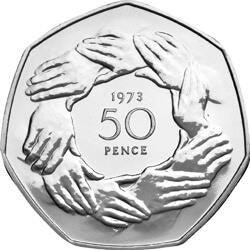In 1973, Britain finally joined the European Economic Community, EEC, after a vote that took place in Parliament where MPs voted 301-284 in favour of joining the EEC.
In 1973, the Royal Mint introduced the first commemorative 50p coin into general circulation in the UK. The European Economic Community 'clasped hands' 50p coin is a symbol of unity between the members of the EEC, and was meant to represent the cooperation between the countries.
This coin is an old-style 50p which has a larger diameter (30mm) compared to the smaller versions that are in circulation now (27.3mm), and although it is not in circulation today, there is a good chance that you own one or have seen one.So let's have a look at what the current market value is today and learn a little more about the coin.
Looking at the most recent information from eBay and Amazon sales, the EEC 50p sells for an average of £3 excluding shipping costs.
The coin's then-revolutionary design provided for easy visual and tactile differentiation from round coins, yet its constant width allowed it to roll through vending machines.
In contrast to other coin types at the time, the 50 pence coin was not equivalent to a pre-decimal coin — it replaced the old ten shilling banknote. The denomination was introduced in October 1969 when the 50p joined the 5p (shilling) and 10p (florin) coins in circulation. This left only the three copper coins (1/2p, 1p, and 2p) to be introduced on 15 February 1971 to complete the new series of decimal coins.
The smaller 5p and 10p coins were introduced in 1990 and 1992, respectively, making the 50p the biggest currency in use at the time. The government of the United Kingdom announced a further assessment of the country's coinage in October 1994.
The findings indicated the need for a smaller 50p coin, which was ultimately issued on September 1, 1997, and kept Christopher Ironside's original design. The reverse of the majority of the huge 50p coins in circulation featured Britannia, a symbol of British coinage since 1672. But on three instances, the denomination was used to mark significant occasions, and for each occasion, a fresh reverse design, like this one, was created.
This coin honours the United Kingdom's entry into the European Economic Community (EEC). As we said, it is the first commemorative 50p coin to be produced and it is also the first time that the date was on the reverse rather than the customary obverse.
1973 saw the absence of 'normal' circulation type (sitting Britannia) 50 pence coins.
Before the size of the 50p coin was changed in 1997 and the previous (larger) pieces were taken out of circulation; they were demonetised in 1998, coins created in 1973 were in circulation for 25 years.
Design of the Coin
The EEC 50p reverse features a ring made up of nine hands that are connected.

This depicts the nine nations that comprised the European Community in 1973, following the inclusion of Denmark, Ireland, and the United Kingdom.
David Wynne, a sculptor whose work we shall look at later in the article, was responsible for the design.Due to its iconic shape, this design is often referred to as the '50p with hands' and the 'ring of hands 50p.'
Arnold Machin's image of the Queen is on the obverse. Her Majesty is donning a tiara that reads 'Girls of Great Britain and Ireland.' The Tiara was a 1947 wedding present from Queen Mary. Her Majesty's grandmother was Queen Mary. Until 1984, this image was in use. The Queen is depicted in the Ian Rank-Broadley portrait wearing the exact same tiara.

She is dressed as a young bust, facing right, and she is crowned. This picture is also known as the Second Portrait. The monarch's legend is written all around her in Latin and reads, 'ELIZABETH II D G REG F D,' which means, 'Elizabeth the Second, by the Grace of God, Queen, Defender of the Faith.'
On her right, ELIZABETH II is curled along the outer rim. On the left side of her face, along the outside rim, the remainder of the legend is bent.
The coin's reverse designer
British sculptor David Wynne specialized in creating portraits, figures, and animals. In 1964, he created a famous sculpture of The Beatles. The Maharishi Mahesh Yogi, who had an enormous impact on the band's songs and philosophical outlook, was also introduced to the Fab Four by him. Additionally, Wynne created a sculpture of Maharishi Mahesh Yogi.
In 1994, Wynne was awarded the Most Excellent Order of the British Empire (OBE).
He only ever designed the reverse side of the EEC 50p coin. Instead of the final design's nine hands, he had originally proposed utilizing a ring with ten hands.
The anticipated number of members fell from 10 to nine between the time he started developing his design and the formal minting of the currency.
He used his own hands, those of his wife, and those of one of his sons as models. He also employed a craftsman to help in his workshop and a girl to help take care of his kids.
One of the girl's hands was the one that was missing. Her second hand, which was still included in the final 9-hand form, stands out as being more delicate. He did not intend for any of the hands to stand in for a particular Community member, though.
Mintage of the 1973 EEC 50p coin
The 1973 EEC 50p was the first commemorative 50p design to ever be made available to the public and had a mintage of 89,775,000.
The Royal Mint also released uncirculated versions of the coin in the annual proof sets, along with silver proof piedforts and other commemorative special packs.
Is this 50p rare?
This is a very high mintage figure so the coin is certainly not a rare one.
To put this in perspective, the 1992 Single Market 50p, which also honours the European Union, had the lowest mintage of any old-style commemorative 50p at 109,000.
However, it is nearly 50 years old and is no longer in circulation so you will not find it in your change today. There is still a demand for this coin and a lot of collectors who are starting coin collecting, will tend to start at the first commemorative 50p.
Others have been kept as a memento to mark the historical event and this will increase the scarcity.
How much is it worth?
Examples of the 1973 50p have been sold on auction sites such as eBay and Amazon for around £3, and like we said you will no longer receive this in your change so to obtain one you will have to purchase this coin on the second hand market.
Where can I buy the 1973 EEC 50p coin?Buy this coin direct from Copes Coins.
Online market places such as eBay and Amazon have these coins available, please do your homework on the seller and whether you will then need to add postage onto the listed price.
The Royal Mint has an online shop where you can buy various coins in circulated, uncirculated, silver proof and gold proof condition, but as we mentioned, they no longer stock this coin due to it being nearly 50 years old.
Are there any known errors for the EEC 50p coin?
The Royal Mint have not confirmed any known errors of this coin so beware of any sellers saying they have error versions of this coin.
Bit of trivia...
The clasped hands on the 1973 EEC 50p coin symbolize the union of the European countries and their determination to work together for a bright future. This coin is a reminder of the importance of cooperation and unity in order to achieve success.
This is the fourth coin to commemorate our ties with Europe, the 1992 / 1993 dual date 50p, the 1998 EU stars 50p and the 2020 Brexit 50p are the other three.

